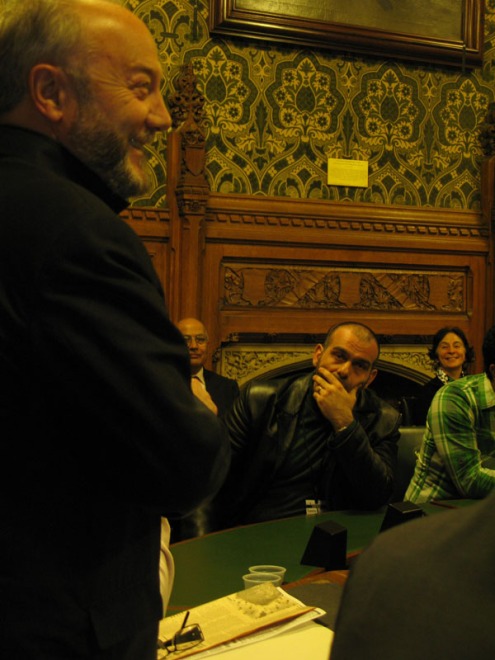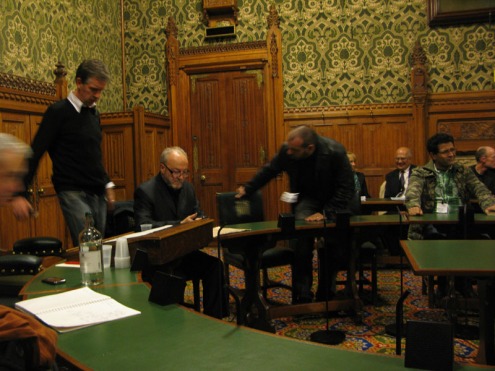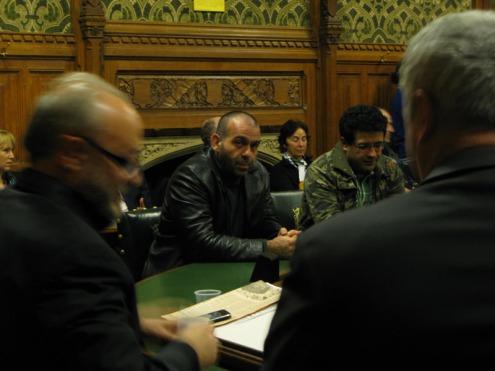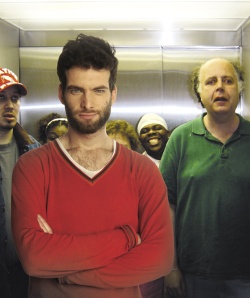Why we should let Tupac rest
Two American rappers about to go on tour are considering reviving their colleague to join them in holographic form – because he’s dead. Earlier this week CGI wizardry allowed Tupac Shakur, gunned down in Las Vegas 1996, to join his contemporaries Snoop Dogg and Dr Dre at the Coachela festival in California to perform his song Gangsta Party.
Pac had barely changed at all: muscles rippling, bounce, and his distinctive tattoo, if now rather ironically, declaring: Thug Life.
The holographic Pac was so animated that he made his duet partner Snoop, look like the dead one. He strutted about the stage with impossible energy as the Dogg, dressed in dark tones, cut a shadowy figure, upstaged by the bizarre spectral spectacle of his former peer.
Rather eerily, Tupac addressed the festival by name “What’s up Coachela!” – for this is CGI, not archive footage. (He could potentially deliver a lecture on kitchen hygiene in Cantonese)
Now he’s about to go on tour, posthumously, a feat only previously accomplished by Chris De Burgh. Apparently his mother approves. She was “positively thrilled” by her son’s brief return to the stage courtesy of entrepreneur Dre Dre who forked out a considerable sum to fund the resurrection.
While reports suggest some at the festival were unnerved by the live performance, Dr Dre’s investment seems to be paying off with all the publicity generated.
Death and technology fascinate us endlessly – witness new pictures this week of the effects of people who perished on the Titantic. (We’re not going to be satisfied until a head pops through a porthole like in Jaws.)
In the CGI rendering of Tupac death and technology meet – but surely touring a dead man without his consent is wrong, even if his mother says yes. Can such a tour amount to anything more than tomb-raiding.
How can a person rest in peace when they are made to dance on stage – or do dead people lose their right to autonomy.
It all seems a bit tasteless – next we’ll hear Gunther van Hagens, who started the Body Worlds exhibition, has leant Dr Dre one of his corpses to recreate the rapper proper.
If you put the dazzle aside – and let’s face it, this is nowhere near as impressive has R2-D2’s projection of Princess Leia in Star Wars – death is being exploited for profit.
Whitney Houston, Amy Winehouse and Michael Jackson could be back before we know it. And Martin Luther King will join Barack Obama on the White House lawn.
An iPhone app in 20 years will allow you to invite dead relatives around for Christmas and occasions such as weddings and, in a macabre twist, funerals too.
Click your fingers and hey presto, there’s Nana, on the sofa, knitting away while watching telly, just like she used to.
In his song Life Goes On, Tupac issued instructions for his death: “Bury me smilin’/ With G’s [a couple of grand] in my pocket / Have a party at my funeral”.
But he also communed with a dead friend. “We’re gonna clock now” – the life of hustling continues, he says – “and basically just represent for you baby”; presumably what Dre and Snoop are doing. In How Long Will They Mourn Me, though, he complains of losing his friends: “They should’ve shot me when I was born / Now I’m trapped in the motherfuckin’ storm / How long will they mourn me?” It’s a good question.
Clash of civilizations
Next month a film called Clash Of The Titans will hit your screens. It’s a remake of the 1981 film where Greek gods and monsters, well, clash. If you look closely, in one or two scenes you may see the top of my head or an elbow because last August, I was a film extra.
I’d wanted to be an extra – or background artiste – since 1984’s Indiana Jones And The Temple of Doom. Many of the slave children from the mine sequences in that Spielberg movie were from my school in west London (some went on to work in jade mines in Africa). But the people in my year didn’t know about the casting, it was for the years below.
I must admit to being ever-so-slightly jealous of one boy, Raj Singh, who was two years above me. He went to stage-school at the weekend and landed the plum speaking role of the Little Maharaja of Pankot, sat opposite Harrison Ford at that infamous feast where the heads of monkeys were used as bowls and creepy crawlies were chewed alive.
(According to a dedicated Indiana Jones wiki site, Raj now lives in Illinois and is a ‘flight dispatcher for United Airlines’, but I wouldn’t trust this information.)
Not that I coveted a speaking part. I would have been happy being whipped in the mines like Rajan Das from class 1B, whose smiling face when the slaves were set free got to fill one frame and a good split second of the Spielberg movie.
In Clash, I was cast as a religious zealot barbarian which, being Iranian, I wasn’t happy with; in my own country that’s enough to make me president. Worryingly, the make-up department didn’t add too much to me when I turned up every day at 6am. “Take your glasses off,” they said. No one wore them in ancient Greece. But they did get me to grow a beard.
Often, as an extra, you face the challenge of doing absolutely nothing for hours. You can’t even read a book or listen to your iPod – the costume people will take it off you. One day, dozens of us were sat for what seemed like a thousand years, in a studio where a big fire pit had been constructed. This along with the lighting rigs created an oven-like intensity. I walked around talking to different people, as you do, in the hope that they would let me count their fingers, having run out of my own.
When we were shepherded into action we invariably had to express surprise or fear. I got pulled up for overacting with jazz-hands when the invisible Kraken rose out of the sea.
Next month I have the option of being a film extra again – my head will be shaved and I’ll be waxed all over. This suggests I won’t be wearing much which, with the weather as cold as it is right now, will be just short of physical abuse. Naturally I’ll say yes.
Battleship Potkin
Yesterday award-winning Iranian-born blogger Potkin Azarmehr and I went to the House Of Commons to protest at a public meeting, organised by Stop The War Coalition, where Respect MP George Galloway (pictured, with Azarmehr opposite) was to speak.
The meeting set out to defend the rights of protestors at last year’s Gaza marches in London who have been given harsh sentences by UK courts. With the backdrop of months of violence in Iran against peaceful demonstrators, we thought it would be apt to highlight Mr Galloway’s silence about human rights abuses in Iran, well documented by Amnesty, Human Rights Watch and for that matter, YouTube.
Mr Galloway’s links with Press TV are well known — an organisation that is a mouthpiece for the Islamic Republic.
My fearless companion didn’t waste time before heckling Mr Galloway and I chipped in too although I was very nervous knowing that we were in the Commons and there were police everywhere.
Mr Galloway, pointing to Azarmehr, said this man wants do arrest me and warned him not to (the Open Democracy piece ‘Arrest Galloway’ was actually penned by me). “I wouldn’t if I were you,” I think were his words.
I was surprised and impressed by Azarmehr’s boldness. When Mr Galloway told him the chair next to him was taken he said: “It’s as close as I can get to the Supreme Leader.”
I really wanted to be in the back row but here we were in the front– what a dude.
Here’s us as Mr Galloway starts proceedings. I really used to like George Galloway. But after seeing him cosy up to Islamic fundamentalists over the years, well it’s been disappointing. Oh, and have you seen him shaking hands with Uday Hussein in 1999 and saying: “Your Excellency.. we are with you till the end”.
Here’s us being led out by police. There were cheers (for Mr Galloway). I was sat down and an officer said: “Right, we tell you what happens from here.” We were taken to a room, searched, checked, and then released without charge. The officers were very courteous throughout and at Azarmehr’s suggestion, Google’d us and were impressed to find a clip of him on Newsnight.
Who knows, maybe one day Stop The War Coalition will opt to see Mr Galloway and Islamist fundamentalism to the door instead two humble bloggers.
Thanks to Polona Florijančič for pics.
Comedy this Wednesday: London
CATCH JOSIE LONG SHAPPI KHORSANDI AND TIFFANY STEVENSON AT THE PARADISE BY WAY OF KENSAL GREEN 24 FEB
http://www.timeout.com/london/comedy/event/177313/soul-bean-cafe
COMEDY THIS WEDNESDAY (IN LONDON!)
COMEDY AT THE PARADISE, KENSAL GREEN
WEDS 3 FEB 8PM
………………………………………………………………………
DAN ANTOPOLSKI
“Not merely deadpan, but almost otherworldly on stage.”
James Kettle, THE GUARDIAN 2009
“Spectacular displays of verbal pyrotechnics.”
Stephanie Merritt, THE OBSERVER 2009
with….
TIFFANY STEVENSON
ALFIE BROWN
PEYVAND KHORSANDI
and resident very special guest:
SHAPPI KHORSANDI
DOORS: 7.30PM
START: 8PM
………………………………………………………………
TICKETS: £5
………………………………………………………………
VENUE:
Paradise By Way Of Kensal Green
19 Kilburn Lane, London W10 4AE
CALL: 07983 486 839 / 020 8969 0098
All eyes on Neda
What does Neda Agha-Soltan, listed by Time magazine as one of 2009’s ‘25 people who mattered’, have in common with Saddam Hussein? One angel, the other devil, both died YouTube deaths, etched into the memories of millions.
When Tony Blair told the BBC last week that, WMD aside, he was glad Saddam and his sons were no longer in power, I wondered what he felt about the dictator having been executed (the last person to be hanged in Britain was in 1964 and the death penalty has since been abolished). Did he watch? Was he pleased that our enemy was hanged in that dingy cellar, much as many of Saddam’s victims will have met their deaths.
Far from squealing for mercy, the humiliated middle-eastern despot saw off taunts from his executioners – perhaps his experience in killing people had taught him how to act when it was his own neck in the noose. There was not a peep from Blair about the killing, as his subordinates limply stated that this was the justice that the Iraqis chose to dispense – not us. The important thing, Blair reminds us, is that the Middle East is a better place, especially with him there as a peace envoy.
Neda Agha-Soltan’s death also raised questions – obvious ones, such as how even a brutal regime could be so brutal. But others, too – how many of the hundreds of thousands who have watched her last moments did so more than once? Is it voyeurism? At what point does it become entertainment? And given that Ms Agha-Soltan signed no release form, is it right that footage of her death was posted on YouTube in the first place? Is it not enough to know that someone has been killed? Do we have to see it? Given the choice, might we not choose to prevent the world from gawping at our body as we breathe our last?
The final frame of that video, with blood crisscrossing Ms Agha Soltan’s face, is freely reproduced. It has even been turned into a logo. Her death has been re-enacted – first by anti-Islamic Republic demonstrators in New York (in what seemed like a YouTube mourning ritual, as if trying to make sense of their relationship with technology) and secondly in Iran by pro-regime goons, portraying Ms Agha-Soltan as a tool of UK-meddling in Iran’s affairs, in what was a macabre and tasteless piece of street theatre…
In life, many of us go to pains to look good; yet in death we are deprived of the right to own our own image and story. “Neda” is, anyway. Who knows if she’d have objected to the footage of her last moments being released. Our familiarity with her would then be limited to a news report of a 27-year-old tragically killed by a criminal state.
Unlike Saddam, Ms Agha Soltan owes her fame exclusively to YouTube. He was a brutal dictator. She was killed by one, shot on camera, and is an icon as a result. We feel entitled to doctor and reproduce her image at will, allowing empathy to override rationality – saying “We are all Neda” gives us the authority to remember her as we choose: bloodied, like so many others, confirming our justified outrage against the Islamic Republic.
We do not know her favourite colour, what ice cream she liked, whether she was a tea or coffee drinker; yet “We are all Neda” because we’ve seen her die on YouTube. As Time’s Bobby Ghosh put its: “We’ll never know the man who stood in front of those tanks in Tiananmen Square, but we do know Neda Agha-Soltan: we’ve looked into her eyes… “Within hours, millions of people around the world had been beseeched by those fading eyes, making an intimate connection.”
This implies a reciprocity – as if Ms Agha-Soltan was looking back. Accompanying these words is a still from the YouTube video, hands pumping her chest but, mercifully, no blood. In a world dominated by Ayatollahs, Blairs and Saddams, we should remember Neda Agha-Soltan, surely, for her happy, smiling face. After all, one day before her death, none of us knew who she was.
Live and let die
Last Thursday two prominent Americans spoke about the recent unrest in Iran – President Obama and Kermit the Frog.
In Oslo, Obama made a passing reference to the “hundreds of thousands who have marched silently through the streets of Iran”, while accepting his Nobel prize for peace.
Meanwhile, on Minnesota Public Radio show In The Loop, presenter Jeff Horwich strummed on the guitar while Kermit sang It’s Not East Being (A) Green (Revolutionary):
“Spend each day on the run from the basij… Plain clothes police, they’ll run you over, drag you off to Evin or maybe just beat you in the street with electric batons… Burning pictures of the leader… Green’s getting madder and gutsier each day.”
Perhaps it’s not surprising that Kermit’s stance on the Islamic Republic is tougher than the US president’s: critics consider him a Muppet despite promises of a change from George Bush.
In January Obama invited the Islamic Republic to “unclench its fist”, something it has so far has failed to do. This is despite the olive branch extended to Iran’s ruling clergy in March – the president recorded a special message to mark the Iranian New Year. In it he said he “would like to speak directly to the people and leaders of the Islamic Republic of Iran”.
Thus he ignored the crucial “us” and “them” divide between Iran’s ruling clerics and its people. (On the anniversary of the US embassy siege in November, demonstrators chanted an ultimatum to Mr Obama: “You are either with them or with us” – “Obama, ya ba ma-ee, ya ba oona”.)
After all the violence in the summer, Obama had set out to reassure Islamic Republic. “We do not interfere in Iran’s internal affairs,” he said.
Months before the President had admitted to finding the footage of 26-year-old demonstrator Neda Agha- Soltan’s death “heartbreaking.” He added: “Anyone who sees it knows that there’s something fundamentally unjust about that.
“I have concerns about how peaceful demonstrators and people who want their votes counted may be stifled from expressing those concerns.
“It’s important for us to make sure that we let the Iranian people know that we are watching what’s happening, that they are not alone in this process.”
That Obama might be glued to YouTube delivered no discernible boost to Iran’s green movement. To him, change in Iran was a matter of faith: “We have to believe that justice will prevail.”
Justice, of course, remains elusive. Ms Agha Soltan may be number two in Time magazine’s Top 10 Heroes of 2009 but this is little consolation when Washington’s Nobel peace laureate remains reluctant to back the cause she died for. (No need for 30,000 troops, just a few words: Yes you can.)
In his Norouz message, Obama said: “The United States wants the Islamic Republic of Iran to take its rightful place in the community of nations.” This is at odds with the objective of achieving democracy in Iran – after all, demonstrators have called for an “Iranian Republic” and pictures of Khomeini and Khamenei have been torn up and stamped on.
Meanwhile, an online campaign is growing in support of Majid Tavakoli, the student leader from Amir Kabir University who was arrested by the authorities, made to dress in hejab, and accused of trying to escape dressed as a woman. Men are posting pictures of themselves wearing headscarves in solidarity with Tavakoli, using humour as a weapon.
Obama should take lessons from both them and Kermit the Frog. As for negotiating with the mullahs, send in Miss Piggy.
Friedman’s beliefs

New York Times columnist Thomas L Friedman is not a fan of Obama’s troop surge in Afghanistan: “I’d prefer a minimalist approach, working with tribal leaders the way we did to overthrow the Taliban regime in the first place,” he writes.
(Grease the palms of a few warlords, a colonial tradition.)
He adds: “Given our need for nation-building at home right now, I am ready to live with a little less security and a little-less-perfect Afghanistan.” Tell that to the Department of Homeland Security.
If the world thinks Americans are stupid, Mr Friedman is an apt window into their minds – he is against the troop surge but for rather delusional reasons. “Iraq was about ‘the war on terrorism.’ The Afghanistan invasion, for me, was about the ‘war on terrorists.’ To me, it was about getting bin Laden and depriving Al Qaeda of a sanctuary — period. I never thought we could make Afghanistan into Norway — and even if we did, it would not resonate beyond its borders the way Iraq might.”
Sensibly, he did not expect Afghanistan to turn into a Scandinavian country with a little stardust from the US.
One thing US ‘opinion-formers’ excel at is making rash assumptions about the Muslim “world” (of which even India is a part!): “One of the main reasons the Arab-Muslim world has been so resistant to internally driven political reform is because vast oil reserves allow its regimes to become permanently ensconced in power, by just capturing the oil tap, and then using the money to fund vast security and intelligence networks that quash any popular movement. Look at Iran.”
Let’s do that – in the 1953 the US engineered a coup to depose Iran’s democratically elected prime minister who had just nationalized the ‘oil tap’ and kicked out the British. The US, of course, has no interest in oil.
He writes: “The most important reason for the Iraq war was never W.M.D. It was to see if we could partner with Iraqis to help them build something that does not exist in the modern Arab world: a state, a context, where the constituent communities — Shiites, Sunnis and Kurds — write their own social contract for how to live together without an iron fist from above.”
I remember watching images of the first night of the 2003 Iraq invasion on television – it was definitely an iron first pounding Baghdad and it was definitely from above.
Friedman’s cites “a deficit of freedom, a deficit of education and a deficit of women’s empowerment” as the reason “there are so many frustrated and angry people in the Arab-Muslim world, lashing out first at their own governments and secondarily at us — and volunteering for ‘martyrdom’.”
He adds: “The reason India, with the world’s second-largest population of Muslims, has a thriving Muslim minority (albeit with grievances but with no prisoners in Guantánamo Bay [as if all countries with Muslim populations have representatives in Guantanamo] is because of the context of pluralism and democracy it has built at home.”
Friedman’s solving of the “Muslim-world” problems in a few paragraphs would be entertainingly dimwitted were his views not so in line with US foreign policy. “People do not change when we tell them they should,” he writes. “They they change when their context tells them they must.”
For Friedman, who feels free to talk utter nonsense about an imagined “Muslim world”, alas, the ‘context’ remains firmly in his favour.
Equal opportunities fascism
From Mumbai newspaper Sunday Mid-Day:
Mumbai: The British National Party welcomes its first non-white member, and with him, a brand new chapter of fanaticism
An elderly Sikh man is set to become the first non-white member of the British National Party. Since gaining two seats in the European Parliament in June, the far-right party has become subject to a law that prohibits discrimination on racial grounds.
Its leader, Nick Griffin, has a conviction for inciting racial hatred.
Knowing a legal battle to retain its ‘whites only’ policy could result in bankruptcy, the BNP is working to allow the likes of 78-year-old Rajinder Singh to join its constitution can no longer limit membership to ‘indigenous Caucasians’.

Mr Singh moved to Britain from Punjab in 1967. He lost his father during Partition and makes no attempt to hide his disdain for Muslims. The retired school teacher is so fond of Mr Griffin and his stance against the so-called ‘Islamification’ of Britain that he has acted as a character witness at his trial.
Under Tony Blair, it would have been unthinkable for the BNP to get where it is. Blair joined the US’s illegal invasion of Iraq in 2003. He didn’t listen to his lawyers or the voters. He always believed he was right and still stands accused of having blood on his hands. With such a strong personality around, there was never any room for a small-time wannabe dictator such as Nick Griffin.
Prime Minister Gordon Brown, however, is a less forceful character, clumsily aping the fascists with his “British jobs, for British workers” slogan pandering to the worst instincts of the electorate instead of challenging them.
A few weeks ago 50-year-old Griffin Mr Singh’s buddy was invited to appear on BBC TV’s flagship political debate show, Question Time.
Despite a chorus of objection, the BBC pointed to its commitment to ‘impartiality’ in allowing Griffin to appear (earlier this year, when Israel had bombed Gaza to smithereens, the broadcaster cited impartiality as its reason for refusing to air an aid advertisement).
Eight million viewers later, Griffin is a household name who is looking for a seat in Parliament. And his Punjabi friend is more than willing to support his bid to rid the UK of Muslims. (There is even talk that he will be the first non-white to stand as a BNP councillor!)
Mr Singh told the London Times: “It’s a natural process in the Muslim psyche, to take over. The fear of Islam is well founded, well justified. I don’t hate Muslims. By definition a Sikh is supposed to love all even the enemy.”
Explaining his support for the BNP, he adds: “I am a victim of Islamic aggression. The individual Muslim is a good guy. He is my neighbour, he is working hard. But when they are all together, everybody should be very fearful. The other parties are not standing up for the national interest.”
Mr Singh told the Independent newspaper: “I come from partitioned Punjab that saw a lot of bloodshed in 1947. Anyone escaping that genocide would pray to God, say never again and vote for BNP.”
One YouTube video shows a young Griffin suggesting Sikhs be paid to return to India. “Lots of Sikhs would go home and west London wouldn’t be so crowded at rush hour time. Everybody’s happy.”
But there is a silver-haired lining to this cloud. Shimla-born Mohinder Singh Pujji who flew a Spitfire in the Battle of Britain in 1940 and was one of 18 Indian pilots in the Royal Air Force (and the only one to have flown wearing a turban), has hit out the BNP. The 92-year old is upset by the party’s use of Spitfire imagery on its website having fought the Nazis in World War II, he’s at it again.
“The BNP are wrong to use the (image of the) Spitfire as representative of their party,” he told the Evening Standard. “They forget people from different backgrounds helped in the Second World War. I am proof of this I was flying a Spitfire. I also met Winston Churchill.”
He added: “Even in those days, there were ethnic minorities fighting for the British. I’d recommend the armed forces for young people, regardless of race.”
On the Daily Mail website, a woman called Kate left this comment about Rajinder Singh:
“While I understand that this man is acting out of the pain of his father’s death, he is clearly hugely misguided and extremely ignorant if he seriously believes that the BNP are the answer to his prayers.”
She might have added that the BNP are equally stupid if they believe Mr Singh is the answer to their prayers. If anything, his joining the party is a sign of their demise.
Illustration by Gynelle Alves
Bad loan
Having won the Nobel peace prize in 2003, Iranian lawyer Shirin Ebadi is now the first laureate whose medal has been confiscated by a government. The human rights lawyer is currently abroad and will be thinking about the wisdom of returning to her country – the award was plundered from a safe, along with her French Legion d’Honneur medal and a prize from a German press association.
She told the BBC: “They said they would detain me if I returned, or that they would make the environment unsafe for me wherever I am.”
The Guardian wrote:
The Norwegian foreign minister, Jonas Gahr Støre, described the move as “shocking” and said it was “the first time a Nobel peace prize has been confiscated by national authorities”.
Ebadi is also being asked to pay back-taxes on the £800,000 she received from Norway, which, she says, cannot be levied on prize money.
The news will worry the British Museum which is about to loan the 2,500-year-old Cyrus Cylinder to Iran as part of an exchange agreement – it borrowed antiquities from Iran for an exhibition earlier this year.
The BM is counting on protection from seizure laws in Iran to prevent the Islamic Republic from confiscating what many Iranians believe to be the world’s first human rights charter.
In her speech to the Nobel committee Ms Ebadi said: “I am an Iranian. A descendent of Cyrus The Great. The very emperor who proclaimed at the pinnacle of power 2500 years ago that… he would not reign over the people if they did not wish it. And [he] promised not to force any person to change his religion and faith and guaranteed freedom for all. The Charter of Cyrus The Great is one of the most important documents that should be studied in the history of human rights.”
Given that her medal is now in the hands of the Islamic Republic, the BM should reconsider its loan of the Cyrus cylinder, on which the ‘charter’ Ms Ebadi referred to is inscribed – it is due to go on display in Tehran in January.
According to one source, the chances that the Iranian government will decide to keep the cylinder are “very high”. Iran’s clerics have a history of hostility towards Iran’s pre-Islamic heritage – after the revolution, Ayatollah Sadegh Khalkhali threatened to raze Unesco-recognised world heritage sites with bulldozers.
In 2007 the Islamic Republic ignored a campaign to stop the Sivand dam being built which experts fear will destroy Persepolis. (Khalali did destroy the mausoleum of Reza Shah.)
Britain need only recall standing by as Iran seized 15 Royal Navy personnel in 2007 to know that lending the Cyrus cylinder to Iran is a bad idea – there will be nothing we can do. And it is perfectly conceivable that it will be damaged or destroyed.
In any case, given the recent violence in Iran against peaceful demonstrators, illegal detentions, torture – with reports of physical violations commonplace – the museum is surely duty-bound to deny or at least delay the loan of this priceless antique.
The BM, however, is adamant that the planned loan will go ahead. Given the fate of Shirin Ebadi’s Nobel medal, however, that doesn’t bode well for her hero Cyrus’s cylinder.







